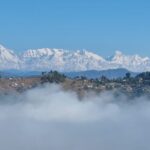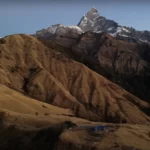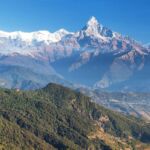Mera Mountain, at 6470 meters, is the highest hiking peak in Nepal. Mera Peak is a Himalayan summit in Mahalangur district, Barun sub-district, and is officially included in Nepal’s Sagarmatha area, Solukhumbu district. Mera Peak is among the great Himalayan excursions, with some of the most spectacular scenes and a fairly isolated route. This, along with the fact that it provides unrivaled vistas and breathtaking panoramas, makes this hiking peak one of Nepal’s most popular mountaineering destinations. If you are a complete novice climber looking to get right into hiking a Mountain peak, Mera Peak 6476M is the adventure for you. Mera Peak isn’t very tough in terms of technical difficulty, but reaching the trek’s top is a difficult task that should not be taken lightly. While technically simple, trekkers are exposed to extremes in temperature and are at an increased risk of getting a number of high altitude diseases such as High Altitude Pulmonary Edema (HAPE), Acute Mountain Sickness (AMS), and High Altitude Cerebral Edema (HACE).
Permits for climbing Mera must be obtained through the Nepal Mountaineering Association, which may be found at www.nepalmountaineering.org. These may be purchased either physically or via a Nepalese trekking organization. The majority of mountaineers travel to Mera from Lukla. A 45-minute flight from Kathmandu will get you there. Furthermore, after a bus or cab journey to Jiri and a 5- to 7-day climb, it is also feasible to reach Lukla overland. Moreover, Mera is notoriously tough to leave. It is required to recede into the Hinku valley prior to actually ascending over the Zatrwa La to return to Lukla (4610m). This can be tough for healthy mountaineers in adverse weather, and extremely difficult for someone who is sick or severely hurt. While helicopter rescue is conceivable, inclement weather can cause it to be delayed for many days. This article explains an acclimatization regimen that gives climbers a good opportunity to reach the mountaintop securely and successfully. It also discusses the frequent challenges that may arise along the road, as well as the remedies required to solve them.
There are four seasons in the Everest area, as there are in the rest of Nepal. Summer, spring, winter, and autumn are the four seasons. Before the monsoon, from February to May, and after the monsoon, from October to December, are the most popular months for trekking expeditions to Mera Peak. You may also hike Mera Peak during the monsoon season, although it will be much quieter. What has to be noted is that each hiking period has its own thrill and environment for climbers, but if you really want to be certain of the meteorological conditions during your journey, adhere to the peak season.

A six-thousand-foot peak should not be climbed with just anyone. If you’re traveling from afar, you’ll want someone on your side to assist you with the planning. You wouldn’t want to rush into the actual ascend, but you do want to have the chance to utilize the proper climbing equipment. When you’re out in the mountains, your kit is your lifesaver. It doesn’t matter where you’re going; your gear is essential. Lack of gear may lead to disastrous consequences and death in harsh situations. In any case, having the proper equipment might be the difference between having a nice time and being unhappy. You’ve purchased your tickets, your Nepali guide is waiting for you, and now you’ve arrived with an overly heavy rucksack, a thin jacket, and shoes that will almost certainly cause blisters. What a waste of time. Make the most of your trekking by packing the correct gear.
Here’s a list of basic equipment that one needs while trekking the Mera mountain:
- Insulating base layers
- Waterproof and/or windproof jackets
- Waterproof and/or windproof trousers
- Hiking shoes and socks
- Thermal Tops and inners
- Trekking Poles
- Warm gloves
- Ice ax and ice screws
- Harness
- Descender/ Ascender device
- Ice hammer
- Crampons
The Mera Peak essentials listed above can be leased directly from your hiking company. There’s obviously something extra that you can carry and bring with you. Because everyone is different, they all have distinct needs.
As for booking your Mera Peak trip, there are several websites where you can do so but beware of inexpensive packages as they tend to be a bit careless and might just ruin your experience. Instead, going for one with reasonable pricing or a high-end package is the best option for those who can afford it.




